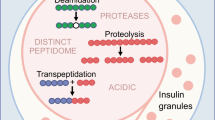Abstract
Mice and rats injected with alloxan or streptozotocin develop permanent diabetes, characterised by deficient insulin production. It has been demonstrated that hypoinsulinaemia in mice leads to significant loss of lymphatic tissue1,2, and these diabetic animals cannot develop contact sensitivity1 or efficient graft rejection3,4. Administration of insulin partially restored these responses1,4 and also caused an increase in the weight of the thymus and spleen1. Similar suppression of T cell-dependent phenomena has been observed in surgically pancreatectomised rats5. Lymphocytes of these hypoinsulinaemic animals show significantly decreased in vitro responses to plant lectins2,6,7 and generate only low levels of cytotoxic effector cells2,7. We previously showed that cells of normoglycaemic oxazolone-sensitised mice cannot transfer significant contact sensitivity reactions into diabetic recipients1 indicating that the milieu of hyperglycaemic insulin deficient animals cannot support all the activity of immune T cells. By mixing immunised T cells from control and diabetic mice and transferring the mixtures into normal recipients we now show that the non-supportive milieu in diabetic animals may be due to active suppression rather than to athrepsis.
Similar content being viewed by others
References
Ptak, W., Czarnik, Z. & Hanczakowska, M. Clin. exp. Immun. 19, 319–325 (1975).
Nichols, W. K., Spellmann, J. B. & Daynes, R. A. Diabetologia 14, 343–349 (1978).
Pierpaoli, W., Fabris, N. & Sorkin, E. in Cellular interactions in the immune response. 2nd int. Convoc. Immun., 1970 Buffalo, New York, 25 (Karger, Basle, 1970).
Mahmoud, A. A. F., Rodman, H. M., Mandel, M. A. & Warren, K. S. J. clin. Invest. 57, 362–367 (1976).
Fabris, N. & Piantanelli, L. Clin. exp. Immun. 28, 315–325 (1977).
Pallavicini, M. G. & Nichols, W. K. Diabetes 24, 614–622 (1976).
Brown, D. M., Yunis, E. J. & Fernandes, G. Fedn Proc. 36, 1258 (1977).
Asherson, G. L. & Ptak, W. Immunology 15, 405–416 (1968).
Rozycka, D. & Ptak, W. Immunology 35, 229–235 (1975).
Reif, A. E. & Allen, J. M. V. J. exp. Med. 120, 413–433 (1964).
Julius, M. M., Simpson, E. & Herzenberg, L. A. Eur. J. Immun. 3, 645–649 (1973).
Ptak, W., Rewicka, M. & Rozycka, D. Clin. exp. Immun. 29, 140–146 (1977).
Strom, T. B., Bear, R. A. & Carpenter, C. B. Science 187, 1206–1208 (1975).
Helderman, J. H. & Strom, T. B. J. clin. Invest. 59, 338–344 (1977).
Krug, U., Krug, F. & Cuatrecasas, P. Proc. natn. Acad. Sci. U.S.A. 69, 2604–2608 (1972).
Cantor, H. & Boyse, E. A. J. exp. Med. 141, 1376–1389 (1975).
Cantor, H., Shen, F. W. & Boyse, E. A. J. exp. Med. 143, 1391–1401 (1976).
Cantor, H. & Gershon, R. K. Fedn Proc. 38, 2058–2064 (1979).
Arrembrecht, S. Nature, 252, 255–256 (1974).
Shearer, G. W., Weinstein, Y. & Melmon, K. L. J. Immun. 113, 597–603 (1974).
Author information
Authors and Affiliations
Rights and permissions
About this article
Cite this article
Ptak, W., Rewicka, M. & Kollat, M. Development of specific suppressor cells in hypoinsulinaemic mice. Nature 283, 199–200 (1980). https://doi.org/10.1038/283199a0
Received:
Accepted:
Issue Date:
DOI: https://doi.org/10.1038/283199a0
- Springer Nature Limited
This article is cited by
-
Disordered cellular immunity in type 1 diabetes of man and the BB rat
Survey of Immunologic Research (1982)




